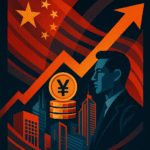Key Points
- Drastic Stock Drop: On August 15, 2025, Applied Materials’ (Yingyong Cailiao 应用材料) stock plunged over 14%, wiping out more than $21.2 billion USD in market value due to a grim future sales and earnings forecast.
- Weak Outlook vs. Strong Past Quarter: The stock drop was triggered by a projected fourth fiscal quarter revenue of ~$6.7 billion (vs. $7.32 billion expected) and EPS of ~$2.11 (vs. $2.38). This overshadowed a surprisingly strong third fiscal quarter that beat expectations with $7.3 billion USD in revenue and $2.48 USD non-GAAP EPS.
- Industry-Wide Impact: Applied Materials’ weaker outlook, driven by decreased demand, a slowdown in China, export delays, and tariff issues, caused other chip equipment makers like KLA Corp and Lam Research to drop 8.4% and 7.3% respectively.
- Strategic US Investment: Despite challenges, Applied Materials is investing over $200 million USD in a new components factory in Arizona, aiming to strengthen its position in the “Made in America” initiative.

A major negative development just sent shockwaves through the semiconductor industry, as Applied Materials (Yingyong Cailiao 应用材料) stock took a massive hit on August 15, 2025.
The US-based semiconductor equipment giant saw its shares nosedive by over 14% in a single day.
This wasn’t just a small dip; it was a staggering market value evaporation of more than $21.2 billion USD (that’s about ¥152.3 billion RMB).
So, what caused the floor to drop out?
A grim sales and earnings forecast has investors spooked about future demand, and the fallout is dragging other major chip players down with it.
Since Applied Materials supplies titans like TSMC (Taiwan Jidian 台积电), Samsung Electronics (Sanxing Dianzi 三星电子), and Intel (YingtelR 英特尔), its performance is often seen as a canary in the coal mine for the entire tech hardware sector. Let’s break it down.
The $21 Billion Nosedive: Breaking Down the Numbers
On August 15, US Eastern Time, Applied Materials’ stock experienced its largest single-day drop since March 2020.
By the closing bell, the stock was down 14.07%, slashing its total market cap to $125.942 billion USD (approx. ¥904.5 billion RMB).
The trigger was the company’s latest financial report, which included a less-than-rosy outlook for the fourth fiscal quarter of 2025.
Here’s how their projections stacked up against what Wall Street was expecting:
- Projected Revenue: ~ $6.7 billion USD. (Analysts wanted $7.32 billion)
- Projected Adjusted EPS: ~ $2.11 USD. (Analysts wanted $2.38)
This miss sent analysts scrambling.
Citi promptly removed Applied Materials from its focus list and chopped its target price down to $205 USD per share.
Stifel analysts followed suit, slashing their target price from $195 USD to $180 USD.

Resume Captain
Your AI Career Toolkit:
- AI Resume Optimization
- Custom Cover Letters
- LinkedIn Profile Boost
- Interview Question Prep
- Salary Negotiation Agent

From the Top: What the CEO is Saying
- Decreasing Customer Demand: Key customers are reducing their orders.
- China Business Slowdown: Lower visibility for business in China due to customers entering an “inventory digestion” phase.
- Export Delays: Approvals for technology exports are being held up.
- Tariff Troubles: Protracted tariff negotiations are causing major customers to postpone purchases.
- Capacity Absorption in China: Expected revenue decline ties to China market capacity.
- Lumpy Demand: Non-linear demand from leading customers linked to new factory construction timing.
Gary Dickerson, CEO of Applied Materials, didn’t mince words about the challenges ahead.
He pointed to a “dynamic macroeconomic and policy environment” that’s creating “more short-term uncertainty and lower visibility.”
Here are the key headwinds he flagged:
- Decreasing Demand: Some key customers are pulling back.
- China Business Slowdown: Dickerson specifically called out lower visibility for their business in China, noting that Chinese customers who bought heavily in recent years are now in a phase of “inventory digestion.”
- Export Delays: Approvals for technology exports are getting held up.
- Tariff Troubles: Protracted tariff negotiations are causing major customers to postpone some purchases.
The company’s CFO, Brice Hill, added that they expect a revenue decline “due to capacity absorption in the China market” and the lumpy, non-linear demand from leading customers tied to the timing of new factory (fab) construction.
But Wait, The Last Quarter Was Actually… Good?

Here’s the plot twist.
Despite the gloomy forecast, Applied Materials’ performance in the third fiscal quarter was surprisingly strong.
They actually beat analyst expectations:
- Non-GAAP EPS: Came in at $2.48 USD, a 17% year-over-year increase (beating the $2.36 expected).
- Revenue: Hit $7.3 billion USD, an 8% year-over-year increase (beating the $7.22 billion expected).
- Profitability: Both gross margin (48.9%) and operating margin (30.7%) improved significantly.
All three of the company’s main business segments—Semiconductor Systems, Applied Global Services, and Display—outperformed sales expectations.
On top of that, management doubled down on its promise to return 80% to 100% of its free cash flow to shareholders.
The Ripple Effect: When a Giant Stumbles, Others Wobble
A company like Applied Materials doesn’t operate in a vacuum.
Because its customers—the world’s largest chipmakers—place equipment orders far in advance, its guidance is a crucial leading indicator for the industry’s health.
The market reaction was swift and widespread. Following the news, shares of other American chip equipment makers also tumbled:
- KLA Corp: Dropped 8.4%
- Lam Research: Dropped 7.3%
This comes after another industry leader, ASML Holding, also recently expressed uncertainty about the impact of US tariffs, signaling a broader theme of geopolitical and economic pressure.
Summit Insights, an investment research firm, downgraded Applied Materials’ rating from “Buy” to “Hold,” pointing to several key concerns:
- Intel Headwinds: Uncertainty around Intel’s next-gen 18A and 14A nodes poses a risk for equipment suppliers.
- Weak Consumer Demand: Sluggish markets for PCs, smartphones, and consumer electronics are expected to weigh on the industry.
- AI Not a Silver Bullet: Summit believes the tailwinds from artificial intelligence won’t be enough to offset the broader market weaknesses in the near term.

Find Top Talent on China's Leading Networks
- Post Across China's Job Sites from $299 / role, or
- Hire Our Recruiting Pros from $799 / role
- Qualified Candidate Bundles
- Lower Hiring Costs by 80%+
- Expert Team Since 2014
Your First Job Post

A Look Ahead: The “Made in America” Angle
It’s not all doom and gloom. Applied Materials is making strategic moves to shore up its future, particularly in the US.
The company is investing over $200 million USD to build a new components factory in Arizona.
Even more interesting is its role in the “Made in America” push.
Applied Materials will be selling equipment to Texas Instruments’ (Dexas YiqI 德州仪器) US factories, which are being built to support the production of Apple (Pingguo 苹果) products.
As Masahiro Wakasugi, an analyst at Bloomberg Intelligence, noted, this move “may strengthen its position as a key supplier of chip manufacturing equipment for advanced semiconductors (used in iPhones).”
The Bottom Line
This is a classic case of the market looking forward, not backward.
A strong recent quarter was completely overshadowed by a weak outlook, fueled by a complex mix of economic softness, inventory adjustments in China, and geopolitical friction.
For now, all eyes are on how Applied Materials stock and the broader semiconductor sector will navigate this period of heightened uncertainty and lower visibility.

ExpatInvest China
Grow Your RMB in China:
- Invest Your RMB Locally
- Buy & Sell Online in CN¥
- No Lock-In Periods
- English Service & Data
- Start with Only ¥1,000




